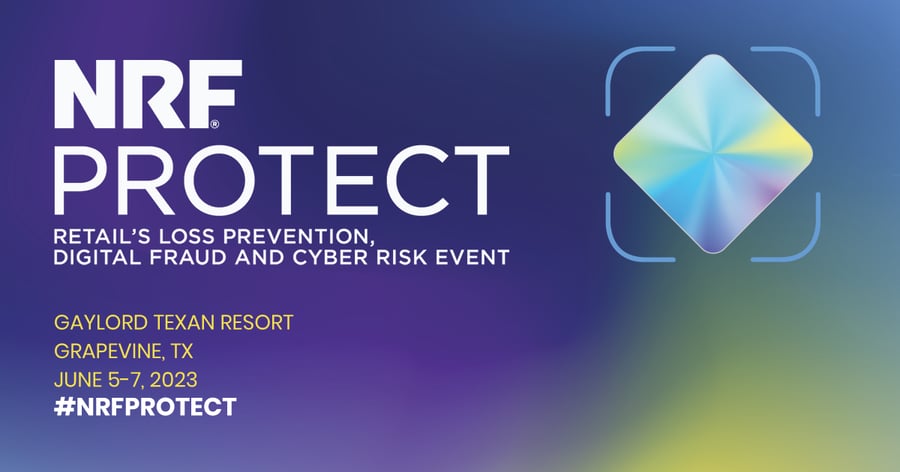NRF Protect 2023: 5 Key Takeaways
 Brian Brinkmann
Brian Brinkmann

The 2023 National Retail Federation Protect or NRF Protect event wrapped one week ago and the $95B retail shrink challenge shows no signs of slowing down. The economic loss has a significant impact on companies and consumers alike. One company cited that a $100 loss at a store has a $260 impact to the company and that cost is going to get passed on to consumers.
Even more concerning is the safety of company employees and the communities they operate. During the keynote, Lowe’s showed videos of brazen theft and violence that had been taken in the last week, suggesting these acts occur regularly. The safety of employees and customers is the top priority for retailers so they can offer positive in-store experiences and contribute to the well-being of their communities.
The good news is that there are techniques and technology that can help companies address shrink and safety. After coming away from the event, I thought I would offer a recap.
1. Safety is Job One
I thought I would borrow the ubiquitous phrase used in every workplace. What really struck me was the frequency, seriousness, and sincerity expressed by companies and vendors alike about their concern for their employees and the public. Watching the Lowe’s keynote video surveillance footage and talking with customers recounting story after story of brash thefts and assaults were deeply disheartening and disturbing. I cannot recall a time when there was such unanimity on any subject backed up with policies, data, and action. Employees are being instructed not to intervene for their safety. As Dr. Read Hayes of the LPRC pointed out in a recent CNN article, criminals can be aggressive and violent. And to back that up, during the event the NRF had an “In Memoriam” section identifying employees killed during normal course of business, many of whom were in their 20s and 30s – far too young. As Lululemon stated in the aforementioned article, “no amount of merchandise is worth the risk to an employee.”
2. eCommerce Challenges Continue to Escalate
On the one hand, the challenges with eCommerce do not generally involve physical danger to employees and customers. On the other hand, fraud is growing. Juniper Research predicts $48 billion in loss from eCommerce, of which 42% will be from retailers in the United States. And eCommerce is very difficult to identify since a card is not present in every transaction. Even worse, the retailer accepts the fraud risk because with EMV or chip card transactions online, the card is not present, making fraud prevention more critical.
eCommerce also includes loyalty fraud where bad actors can take over customers’ accounts and accumulate loyalty points for purchase of merchandise without a credit card. eCommerce challenges occur at every step in the process from ordering; to fulfillment at the distribution center or at the store; to delivery, including third party delivery; to theft at delivery location; to fraudulent claims; and then the entire process of reselling merchandise.
Perhaps the most challenging is the business’s mandate to make the customer experience great while minimizing loss. Many customers are willing to take larger losses in order to gain traction on the eCommerce initiatives. Companies even measure and track an “Insult Rate” or the rate that customers cancel transactions due to offense or frustration to understand lost sales. Often, loss prevention professionals are viewed as business impediments rather than partners. The best retailers are proving that when loss prevention is included in eCommerce (and all) strategic and tactical planning, growth and loss goals are achievable as well as having delighted customers.
3. AI is Here
Not a day goes by without AI being mentioned in the press, c-suite, or by your friends, and its impact on Retail is not just coming but is here now. Walking the expo floor, AI was everywhere: facial recognition, payment processing, video analysis, network defense, and predictive analytics. And with good reason. AI holds the promise to help us do our jobs better and quicker. And that is true for the bad actors too. They are using AI to exploit any vulnerability in stores or online.
The main challenge is how to adopt the new technologies and associated methodologies into companies and their employees. There will certainly be initial distrust of the new information and how best to use it. There will need to be new procedures and employee training so they understand how to use the information. There needs to be learned judgment to interpret the findings and apply rationale that AI does not have. This fact was emphasized many times: AI is a powerful assist to the LP professional who must apply context and experience to unlock AI’s fullest potential. Regardless, every LP professional and department needs to add AI expertise to be effective going forward. Check out the recent Agilence-sponsored IHL Group report “Retail’s AI Revolution” to learn more about the projected impact of AI on retail.
4. Data is the Most Effective Enforcer
While physical deterrents such as gates, locks, and security guards are still effective, data is the best tool to prevent loss and stop bad actors. Transaction data, product data, loyalty data, RFID data, video data, sensor data, human resource data, alarm data, door data – literally nearly everything is emitting data and it can all be used to help find patterns that reduce shrink. Data can identify fraudulent patterns that can be prevented; detect individuals who are stealing; help create policies that reduce shrink; and determine where to invest in training and technology to get the highest return on investment. Of course, data can provide the information needed to prosecute individuals or groups and recover assets and money.
Data also has the benefit of ensuring safety. While our natural inclination is to stop fraud and theft if we see it, it’s very clear our companies care more about employee and customer safety than profit. Allowing crimes to play out and capturing and convicting criminals after the fact with data is safer and more effective than risking personal harm.
5. Collaboration is the Answer
One theme repeated throughout the sessions, keynotes, and on from the vendors is there is not a single answer to solve the shrink challenge. The best way to embrace a multifaceted approach that includes many technologies, people, companies, organizations, and law enforcement. There was a call to the entire ecosystem of loss prevention and asset protection professionals to share data and best practices with each other.
The obvious first place to start is within an organization or company. While still difficult to believe, most companies continue to silo data and struggle to share information across departments like Loss Prevention, Operations, Merchandising, Finance, Security, HR. The companies with advanced loss prevention processes spoke repeatedly about how essential it is to have a cross-functional team talking and sharing and the tremendous value that process yields to the company. Those same companies will tell you that this process is difficult, takes time, persistence, and commitment but is well worth it. The other part is to have data shared between the various systems like loss prevention, video, ordering, workforce management and others. With data flowing effectively, it is possible to reduce shrink and approach business challenges in a more comprehensive and creative way.
Information also needs to flow beyond the boundaries of the organization or company, more freely and faster. Obviously, the National Retail Federation (NRF) and other organizations like the Loss Prevention Foundation (LPF) and the Loss Prevention Research Council (LPRC) have been conducting research, educating people, and lobbying for laws and policy changes – all of which can help in combating and preventing crime, especially organized retail crime (ORC). More concretely, data flowing across organizations from companies to law enforcement makes a tremendous impact. Faster data flow between systems, usually via secure application programming interfaces (APIs), can allow real-time or near real-time responses. Analytics, including AI, can identify patterns and help prevent crime. Lastly, the sharing of technology made freely available to others for the benefit of all, such as Target’s tool for combating online skimming, can be a big help.
While companies and vendors alike are competitors, the overwhelming sentiment was that knowledge needs to be shared in order to address the growing challenges of loss prevention for the good of the industry and the consumer.
Shameless Plug
For over 15 years, Agilence is proud to be a contributing member of the retail community to prevent loss and keep employees and customers safe. Our SaaS analytics platform helps customers save millions by identifying loss in stores and online and providing actionable information to stop it. Working with data integrated from our POS and video partners and using advanced analytics including AI, Agilence can identify retail shrink; investigate, track and gather pertinent information in a case management application; and package and share all the data needed for law enforcement and restitution. We will continue to innovate and collaborate with the retail ecosystem to increase profits and delight customers.
Subscribe to our blog
Receive free educational resources like exclusive reports, webinars, and industry thought leadership articles straight to your inbox.

